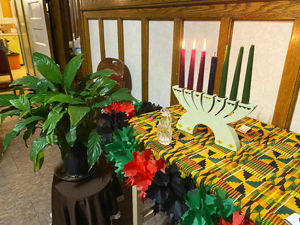
By Don Lynn
Special to The Truth
Kwanzaa was founded in Los Angeles, CA in 1966 after anger over widespread police racism triggered the Watts Rebellion or race riots in 1965.
Harambee was an African-American newspaper originally created in August 1966 by Ron Karenga and Hakim Jamal for the organization US. Karenga then donated the publication to the Black Congress, an umbrella organization for diverse groups i.e., CORE, NAACP, Black Panthers and others. The Los Angeles Black Congress was founded as a community–rebuilding effort in Watts. Its first issue commemorated the anniversary of the 1965 Watts Rebellion. It was instrumental in publicizing the Black Panther idea and symbol in Los Angeles. Activist Elaine Brown was a reporter for the newspaper. Editors included Ron Karenga and John Floyd of the Black Panther Political Party.
By April 1969, the newspaper had returned to its roots as an exclusive publication of Karenga’s US organization.
Maulana is Swahili Arabic for “master Teacher”.
Karenga is Swahili Arabic for “keeper of Tradition”.
Maulana Karenga was born Ronald McKinley Everett on July 14, 1941. He’s an American Professor of African History, an Activist, has numerous Ph.Ds., and is the creator of Kwanzaa.
During the week of Kwanzaa, Dec 26 – Jan 1, families and communities come together to honor the ancestors and to celebrate African and African American culture. Each day we light a candle to highlight the principle of the day. The core value of Kwanzaa is the Nguzo Saba: The seven principles of Kwanzaa.
. Umoja – (unity): maintaining unity as a family, community and race of people.
. Kujichagulia – (self-determination): defining, naming, creating, and speaking for ourselves.
. Ujima – (collective work & responsibility): building and maintaining our community solving problems together.
. Ujamaa – (cooperative economics ): building and maintaining retail stores and other businesses and to profit from these ventures.
. Nia – (purpose): work collectively to build communities that will restore the greatness of African-American people.
. Kuumba – (creativity): to find new, innovative ways to leave
communities of African descent in more beautiful and beneficial ways than the community inherited.
. Imani – (faith): Karenga defines this as faith in community ” to believe with all our heart in our people, our parents, our teachers, our leaders and the righteousness and victory of our struggle”.
Toledo Kwanzaa House (TKH) is the local chapter of “OHIO CELEBRATES KWANZAA” which hosted its first collaboration in 2020 via zoom. It was hosted by: Akron, Cincinnati, Cleveland, Dayton, Kent, Toledo, and Youngstown. The zoom platform allowed us to track participants which was over 2,000 viewers across the states as well as other countries.
Diane Gordon’s family and friends began celebrating Kwanzaa in Toledo in 1967 in her home. As word got out, she and Kewape “Ken” Peterson did public presentations in Toledo and Michigan. TKH developed from that beginning now as a volunteer organization committed to promoting communities and teaching the seven principles.
This year’s Kwanzaa celebration, December 26 – January 1, will be held at the Frederick Douglass Community Association, 1001 Indiana Ave. Toledo, Ohio 43607.
5:00 PM – Pre-Kwanzaa Program
6:00 PM – Kwanzaa Celebration
Official Kwanzaa Website: https://www.officialkwanzaawebsite.org
PLEASE COME OUT AND SUPPORT KWANZAA!!
Asante (Thank you Toledo)
Oweso (Don Lynn)
